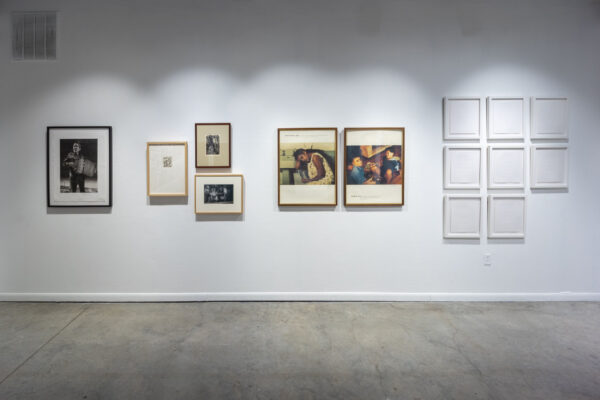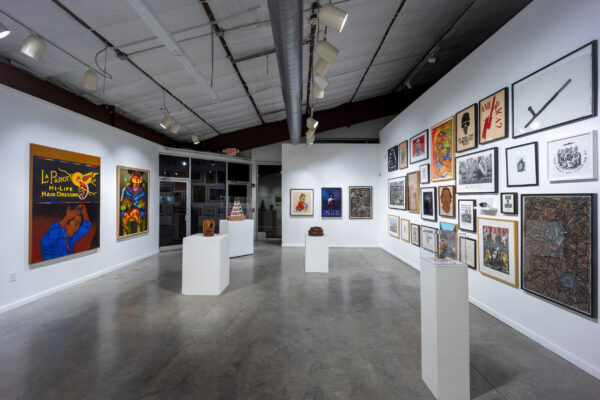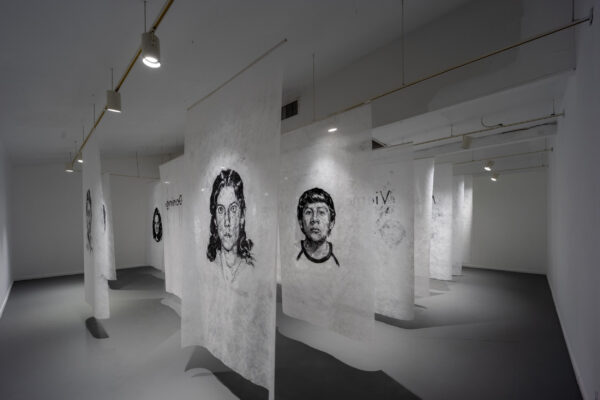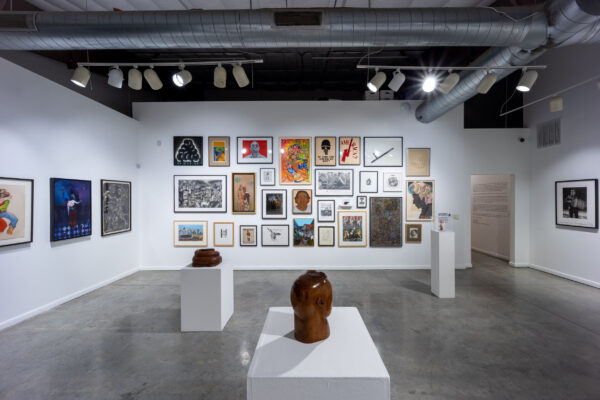
Installation view of Vincent Valdez’s 2023 Texas Artist of the Year exhibition at Art League Houston.
Vincent Valdez was political long before college. His father fought in Vietnam, and this least-liked American war has been a source of questioning unease for Valdez since very early on. In his public appearances, he fondly recounts a particular childhood memory: In 1987, at the age of ten, he asked his parents to record HBO’s famous documentary on Vietnam, Dear America. Listening to letters from the front read by some of the era’s biggest movie stars made him aware how things worked ‘round here. It’s relatively true for most wars, but what really struck young Valdez was that Vietnam was fought by the poor. And the poor were, with notable exceptions, recruited among the minorities. That link between poverty, racism, and violence reappears in his work continuously. He also learned to draw by tracing paused VCR film stills and trying to catch facial expressions. In later work he does not overuse this skill, preferring instead to put the look of somber expectancy on most subjects so long as they are not in KKK garb, as in his well-known and controversial painting The City (2016).
This year, he was declared Texas Artist of the Year by Art League Houston, and instead of keeping the space to himself, Valdez — in true communitarian spirit — shares it with artists from the collection of Joe Diaz. This allows him to establish solidarity with political work of the past and the present in a selection that is good enough for a museum display. It is, indeed, a short but effective history of American art gone left field.
Imagine no multi-million dollar possessions of art as commodity, no market pressure. Imagine, if you dare, that the nation’s museums never took to thinking, after Richard Nixon, that “the United States comes closest to the ideal of prosperity for all in a classless society,” and foregrounded Social Realists like Ben Shahn rather than the gestural excess of Abstract Expressionists. Imagine, further, that the U.S. museums are truly post-racial, including work by white, mestizo, and Black Americans in a communion that is based on class affinities. This is how that world would look, exhibitions-wise. A recent Valdez drawing of conjunto legend Flaco Jimenez next to a minuscule Rufino Tamayo print from 1926; further down hang two prints from Australian photographer Tracy Moffat’s classic series Scarred for Life (1994), and right after, if you’re still not sure what direction this installation is taking, an Adriana Corral (Valdez’s wife) blind print of the Universal Declaration of Human Rights (Latitudes, 2016).

Installation view of Vincent Valdez’s 2023 Texas Artist of the Year exhibition at Art League Houston.
Elsewhere, there is Milton Glaser’s famous 1966 poster of Bob Dylan with the singer’s curls sprouting rainbows, included here because one of the moments in that Vietnam documentary was soundtracked by the Band’s rendition of I Shall Be Released. A life-size portrait of Soviet spy Ethel Rosenberg in her electric chair by Peter Saul is both compassionate and nauseating, as is often the case with Saul, thanks to the glaring colors and human flesh in a state of either melt-down or mutation.
Local heroes (aka early influences) Kathy Vargas, Cesar Martinez, and Luis Jimenez are here, or course, to chart a straight line of political and stylistic continuity. But the most interesting way Valdez introduces his ancestry to the show is through his grandfather Jose Maria Valdez. Progresso/Progress (1939) unites technological and social progress through a female allegory of Mexico. Her pearly-white dress consists of factory fumes. At her feet are railroads with steamrollers and tractors in the fields; above her a plane skywrites the painting’s title in white smoke. The painting is endearingly amateur and styled midway between a retablo and Stalin-era optimistic propaganda. More than anything, it testifies to a uniquely non-contentious way Vincent Valdez has evolved. Anthropologist Arjun Appadurai calls “a dramatic break between past and present,” “tradition and modernity,” one of the “most problematic legacies of grand Western social science.” His qualifier is justified for art history, as well: it thrives on patricide, teenage runaways, and arsonists of the -isms past. Not so for Valdez, who thrives on acknowledgement.

Installation view of Vincent Valdez’s 2023 Texas Artist of the Year exhibition at Art League Houston.
This too, like conflict, can be a blessing and a curse. In fact, museums like this, where folk expression was venerated alongside critical statements in figurative idiom, did exist in the Soviet Union and the Eastern bloc, though in those cultures they appeared as a Cold War argument against the rotten capitalists. These lines of democratic image-making can become tedious and overly didactic just as fast as a given Modernist narrative. To do this right, you have to walk the line.
In regards to Valdez’s own installation at Art League, the line is balanced upon. You enter a room with three rows of portraits printed on large sheets of semi-transparent plastic, feeling as if you’re playing hide and seek on a farm after laundry day. Every now and then, a sheet with a weekday name in Spanish cuts through the sequence. There’s nothing sentimental or histrionic about those portraits, no extra dates or documents attached. From the wall text we know that the people in these portraits were killed in Latin America by regimes either sponsored or installed by a U.S. administration. Weekdays sharply point to the fact that the murders were banal, par for the course, and as inescapable as a new day’s dawn. These are the fingerprints of history, and the lines of these faces indeed resemble a finger pad’s squiggly lines.
What about the effectiveness of the image? Can it grasp the history itself? Portraiture is an easy genre to employ if you want to instill a sense of historical gravity. A face ignites recognition, more so than a name, in that it states the very fact of a life lived and persuades us to believe in its significance. More so if the face is rendered on a monumental scale, as is the case with Valdez’s exhibition, the community portraits of French street artist JR, and other examples.

Installation view of Vincent Valdez’s 2023 Texas Artist of the Year exhibition at Art League Houston.
The question, then, is if the message functions as it’s supposed to. Valdez is fond of the famous Gore Vidal quote, “We are the United States of Amnesia, we learn nothing because we remember nothing,” and his life’s project is to work against forgetting, to dig up traumatic pasts the U.S. doesn’t want to remember, so they never happen again. One wonders, though, if this memorializing is just palliative care for a patient who’s too far gone.
In Valdez’s famous series The Strangest Fruit, he communicates the history of the lynching of Mexicans following the 1848 signing of the Treaty of Guadalupe Hidalgo to the present by depicting recognizably modern Tex-Mex men, eyes closed, muscles slack, basked in the Texas sunset against an aggressively white background, like cut-outs in heaven. These paintings make us know more by catching us into a visual trick, a paradox of light that can mean anything. Historic portraits hardly have the same appeal. Moreover, the national borders of amnesia are guarded by the world’s largest defense budget (three times bigger than the closest competitor, China) and the most sugar consumed per capita (this white powder is linked to memory loss). On the other hand, the U.S. has the biggest number of history professors in the world, and Texas leads in this metric nationally. Maybe there is some hope, after all, for the light that comes shining from the west down to the east.
2023 Texas Artist of the Year: Vincent Valdez is on view at Art League Houston through December 2, 2023.


